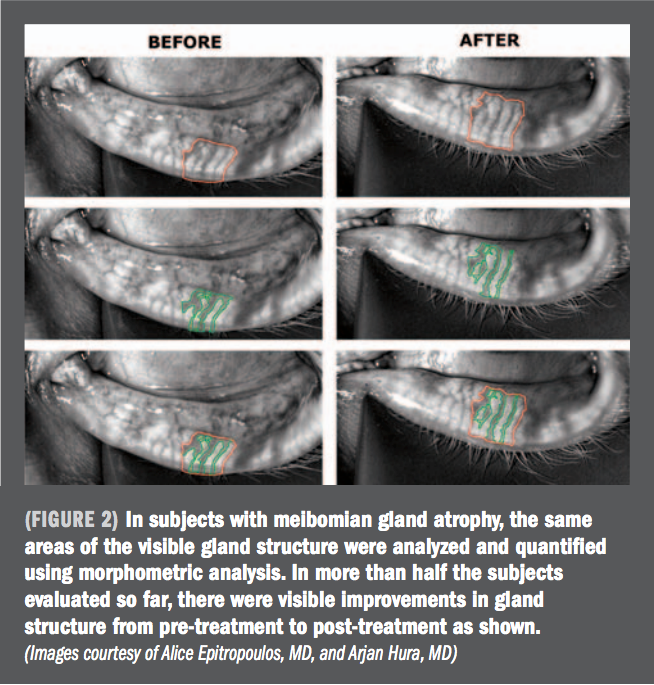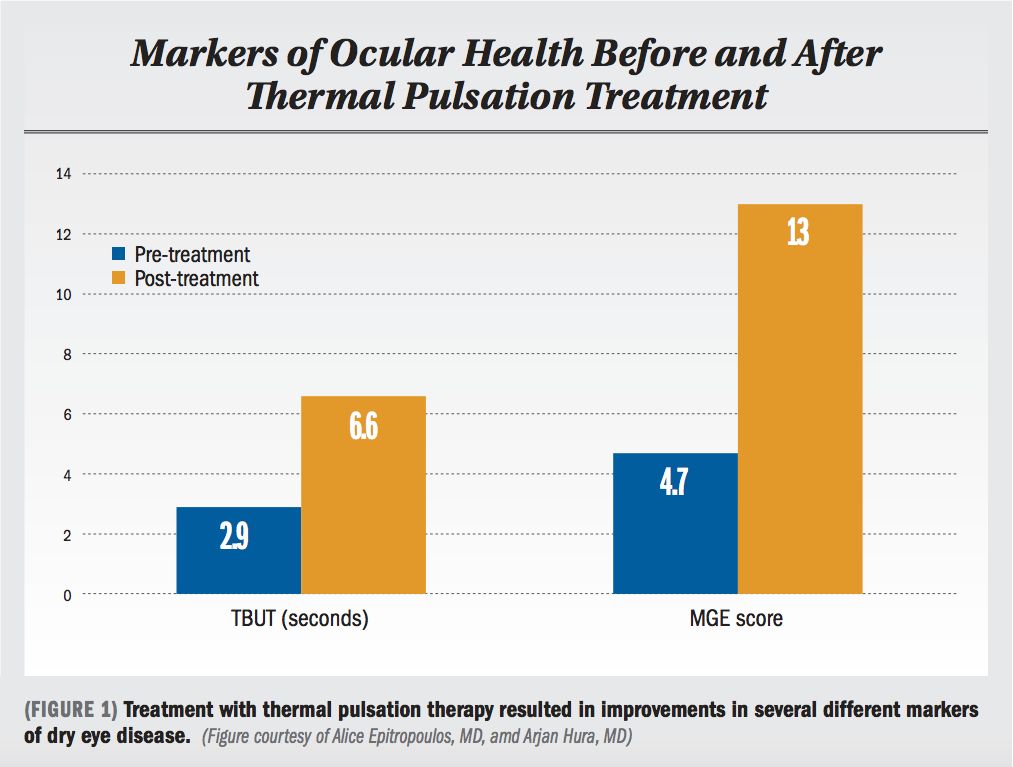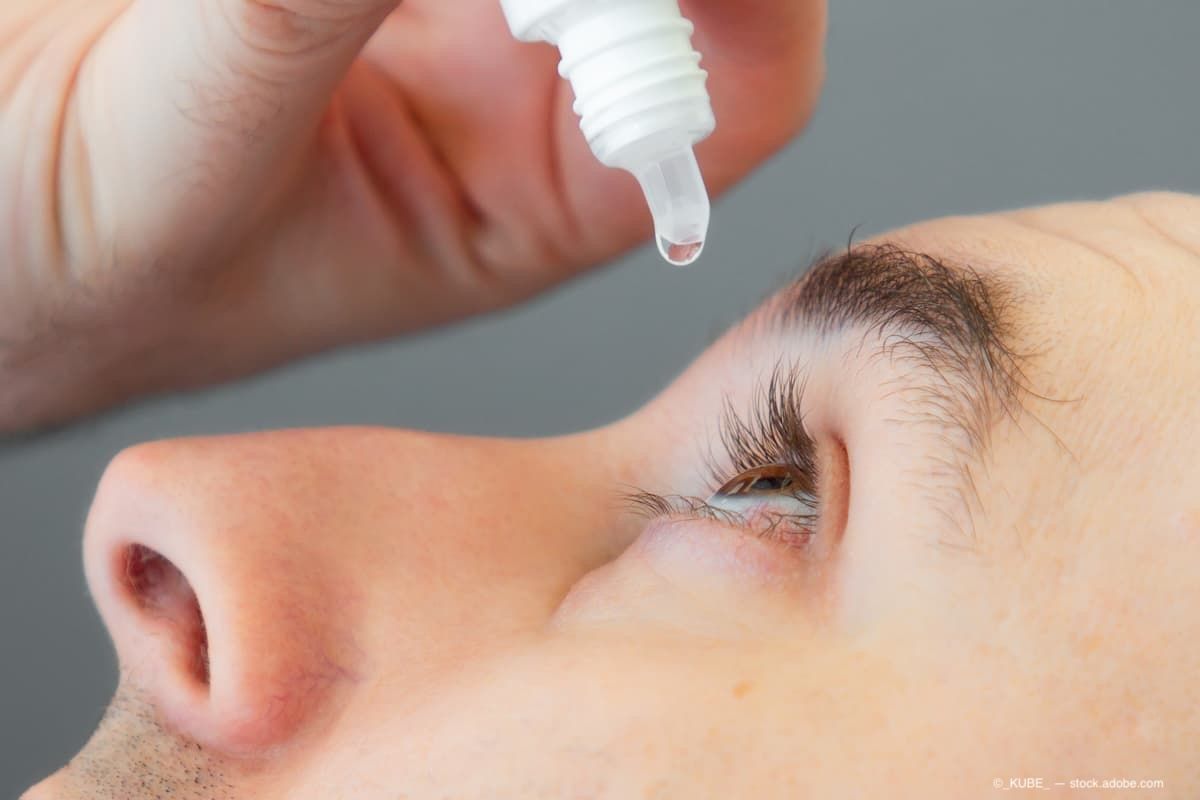Article
Exploring the reversibility of meibomian gland atrophy
Author(s):
Thermal pulsation therapy has potential to improve gland structure in most patients.


Alice Epitropoulos, MD, and Arjan Hura, MD, conducted a retrospective, observational study to determine whether there were changes in the visible gland structure (VGS) of the lower lids of patients who had undergone thermal pulsation therapy.
Most patients with dry eye disease have meibomian gland dysfunction (MGD) as a primary or contributory cause of their ocular surface problems.1 We know that MGD is a progressive disease that gets worse the longer it goes untreated. Over time, the glands become obstructed, which then leads to meibomian gland atrophy.
Established treatments for MGD include re-esterified omega-3 fatty acid supplementation, lid hygiene measures (lid scrubs and warm compresses), blepharoexfoliation, and thermal pulsation therapy. Thermal pulsation therapy has been widely viewed as most effective when performed earlier in the disease process, before a patient reaches end-stage MGD with significant gland atrophy and dropout.
Although it was previously unknown whether thermal pulsation therapy could reverse gland atrophy, the general consensus is that atrophy is permanent. In order to evaluate this presumption more closely, we conducted a retrospective, observational study to determine whether there were changes in the visible gland structure (VGS) of the lower lids of patients who had undergone thermal pulsation therapy.2
Study design
We identified 102 patients who had undergone thermal pulsation therapy (LipiFlow, Johnson & Johnson Vision) 1 to 2 years prior and for whom high-quality, pre-treatment dynamic meibomian imaging (DMI) (LipiView II, Johnson & Johnson Vision) was available.
Patients were brought back for follow-up as part of the current study. In addition to repeating the DMI, a battery of dry eye testing was re-evaluated, including a SPEED questionnaire, tear break-up time (TBUT), corneal staining, osmolarity, MMP-9, and meibomian gland evaluation. All parameters were compared pre- and posttreatment.
Data were also compared with those of a control group of patients (n=32) who received DMI and a recommendation for thermal pulsation therapy in the past but who did not undergo treatment. We used Adobe Photoshop to look at the DMI at a pixel-by-pixel level. Using manual tracing, we were able to precisely evaluate sectors of the lower eye lid for the amount of VGS and amount of atrophy and dropout over time.
This is in contrast to other studies that have utilized estimation, grouping into broad categories, or mathematical algorithms to simplify the quantification of visible meibomian gland structure. Our method allowed for a precise quantification and comparison of the degree of atrophy in the glands in specific regions in pre- versus post-treatment imaging and compared results with the control group.
Results
Data collection is complete for 56 eyes (39 treatment and 17 control). In comparison with the control group, for the eyes receiving treatment (Figure 1), TBUT increased by 4.2 seconds (p = 0.0001), slit lamp meibomian gland evaluation improved by 7.9 points (p = 0.001), and there was an improvement in corneal staining (p = 0.004).
Of the 39 treated eyes, 69% showed an improvement in VGS, with most showing a modest (≤10%) improvement. In the untreated control eyes, only 29% had some improvement in VGS, while 71% had a decline in VGS.
Figure 2 (see Page 22) shows the change in gland structure in several eyes before and after treatment. Post-treatment evaluation of the remaining subjects is ongoing. Completion of this study, as well as further research, is needed to definitively determine whether LipiFlow therapy can reverse gland atrophy and potentially restore MG function in previously atrophied glands.
Discussion
There have been several published reports of long-term results after treatment with LipiFlow.3,4 Consistent with those reports, we saw a significant improvement in tear osmolarity, TBUT, corneal staining and MGE slit lamp evaluation in the treatment group compared to the control group even in cases that were 2 years post-treatment.
Beyond the durability of the treatment effect, the potential for the meibomian glands to reactivate once they have atrophied was also quite interesting. In the past, researchers and clinicians have typically estimated gland atrophy using a grading system with large gradations.
There are two commonly used scales with a grading of 0 to 3 or 0 to 4, where 0 represents no disease and grade 3 or grade 4 represent end stage disease with loss of more than 67% (grade 3 max scale) or more than 75% (grade 4 max scale) of the gland structure.
These grading systems are useful to group patients by disease severity (none, mild, moderate, severe) but they are not sensitive enough to register more subtle changes over time. In this study, the improvements in VGS were typically 10% or less, which would not register as a change on the gross scales but nevertheless represents a significant clinical improvement, especially if one compares that to the expected progression of gland loss in untreated eyes.
To our knowledge, this is the first time that reversibility of gland atrophy has been shown. Better understanding when meibomian gland atrophy begins, how it progresses, and whether it can be reversed is likely to be important in the future.
Not only is MGD highly prevalent in the population, but recent research suggests that the proliferation of smartphones and other digital devices is affecting meibomian gland health very early in life. More than 40% of children and teens evaluated in a recent study had evidence of meibomian gland atrophy.5
It is encouraging that a single thermal pulsation treatment can have long-lasting results and, in some patients, improve the VGS. It is also important to recognize that patients may have multifactorial disease.
If they also have aqueous deficiency and associated inflammation, for example, we would start them on immunomodulatory therapy and a high-quality nutritional supplement,6 and then proceed with thermal pulsation treatment.
Additionally, if the patient is considering ocular surgery, it is critical to treat the ocular surface disease before proceeding with surgery, as MGD and dry eye can lead to inaccurate measurements and patient dissatisfaction.7
Disclosures:
Alice Epitropoulos, MD
E: eyesmd33@gmail.com
Dr. Epitropoulos is in private practice at Ophthalmic Surgeons and Consultants of Ohio and is a clinical assistant professor at The Ohio State University. She is a consultant for Allergan, BlephEx, Johnson & Johnson Vision, PRN Nutriceuticals, Shire, and TearLab.
Arjan Hura, MD
E: huraas@mail.uc.edu
Dr. Hura is an ophthalmology resident at the University of Cincinnati. Investigator initiated financial support for this study was provided by Johnson & Johnson Vision.
References:
1. Lemp MA, Crews LA, Bron AJ, et al. Distribution of aqueous-deficient and evaporative dry eye in a clinic-based patient cohort. Cornea. 2012;31: 472-478.
2. Hura A, Epitropoulos A, Czyz C, et al. The potential effect of LipiFlow on meibomian gland structure: A repliminary analysis utilizing dynamic meibomian imaging. ARVO Poster 935 –B0113, 2018.
3. Greiner JV. Long-term (3-year) effects of a single thermal pulsation system treatment on meibomian gland function and dry eye symptoms. Eye Contact Lens. 2016;42:99-107.
4. Blackie CA, Coleman CA, Holland EJ. The sustained effect (12 months) of a single-dose vectored thermal pulsation procedure for meibomian gland dysfunction and evaporative dry eye. Clin Ophthalmol. 2016;10:1385-1396.
5. Gupta PK, Stevens MN, Kashyap N, Priestley Y. Prevalence of meibomian gland atrophy in a pediatric population. Cornea. 2018;37:426-430.
6. Epitropoulos AT, Donnenfeld ED, Shah ZA, et al. Effect of oral re-esterified omega-3 nutritional supplementation on dry eyes. Cornea. 2016;35:1185-1191.
7. Epitropoulos AT, Matossian C, Berdy GJ, et al. Effect of tear osmolarity on repeatability of keratometry for cataract surgery planning. J Cataract Refract Surg. 2015;41:1672-1677.
Newsletter
Don’t miss out—get Ophthalmology Times updates on the latest clinical advancements and expert interviews, straight to your inbox.




